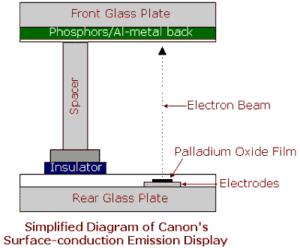FEDs have proved difficult to develop and many companies had dropped their development projects in favour of other technologies. One company, however, has been working on a variation of the FED which currently looks to be a good contender for commercial production due to its simplicity and lower production costs. The company is Canon and the FED-variant is the Surface-conduction Emission Display (SED).
The SED uses a thin film of Palladium Oxide as an electron emitter, instead of the spindt tip used in the FED. It is said to have several advantages over the FED, particularly in the manufacturing stage, which uses a combination of ink-jet and silk-screen printing, requires no semiconductor technology and does not need to be performed in a vacuum or special gases. The SED also draws less power than a FED in operation. Earlier this year, Canon announced that it had partnered with Toshiba to develop SEDs suitable for use in TVs and the companies hope to be producing around 50,000 units a month by 2002.
Update: SED has proved a little more difficult than hoped to get into mass production which is planned for 2007 at the time of writing. Demonstrations of the technology have been made, but often in a darkened environment.

